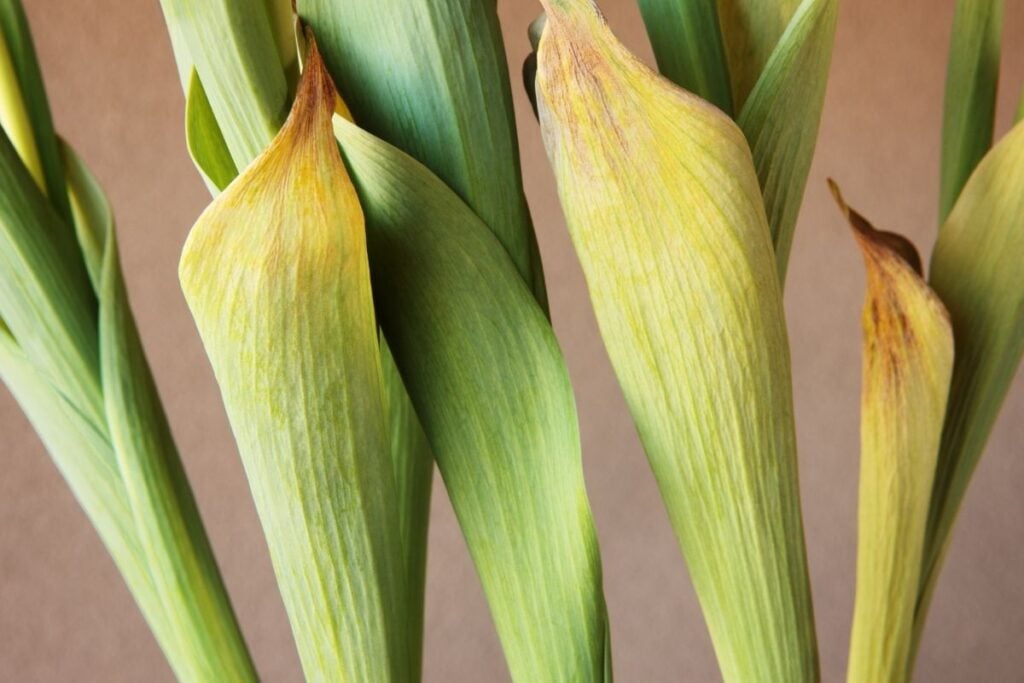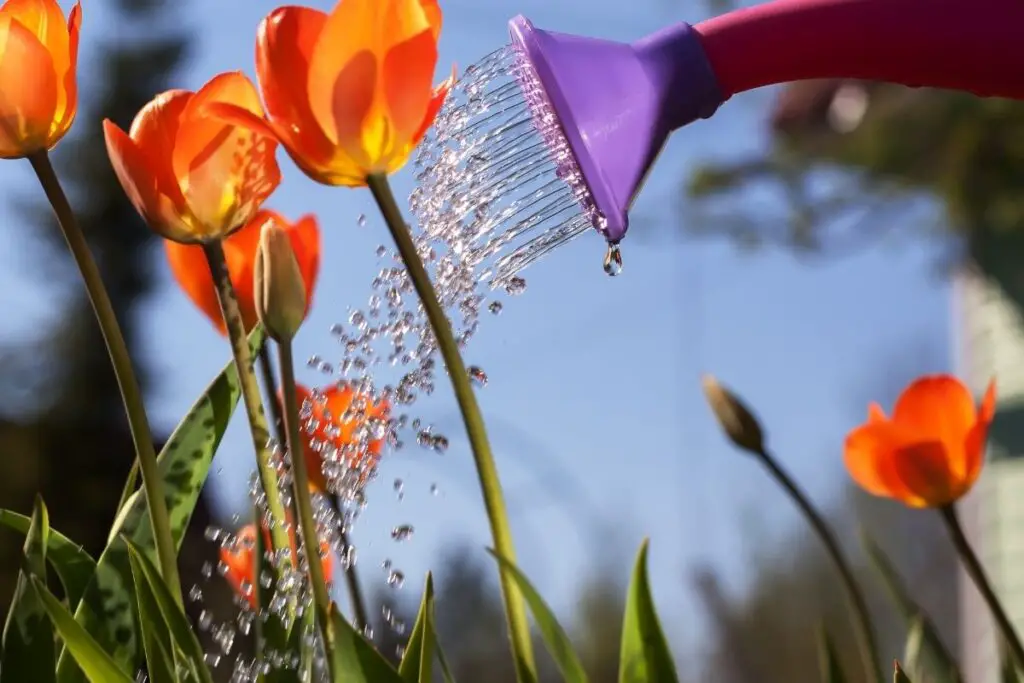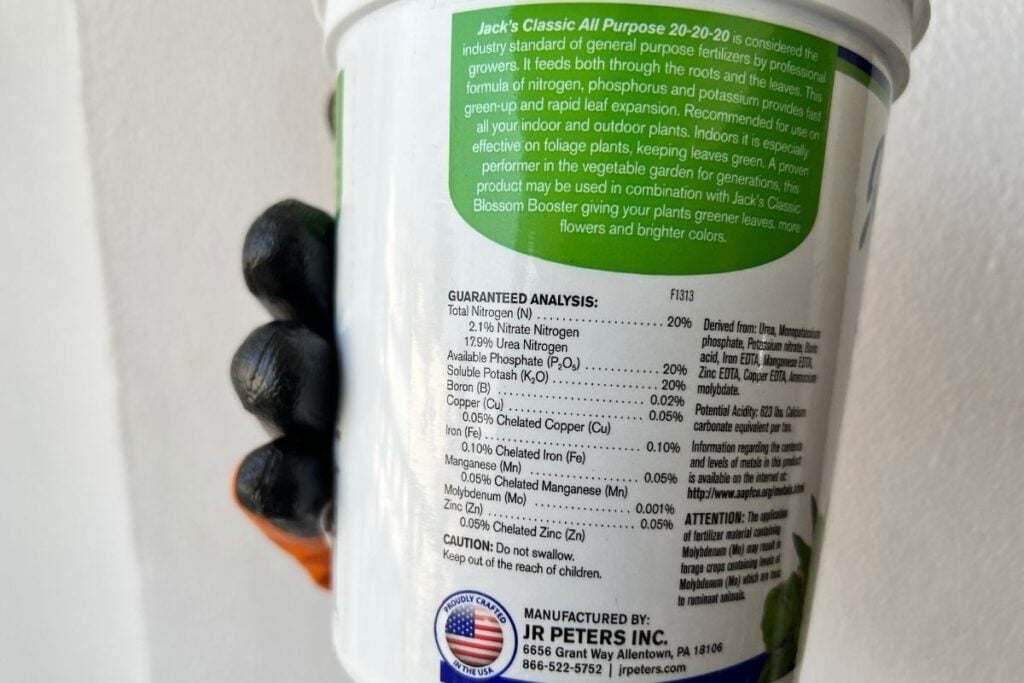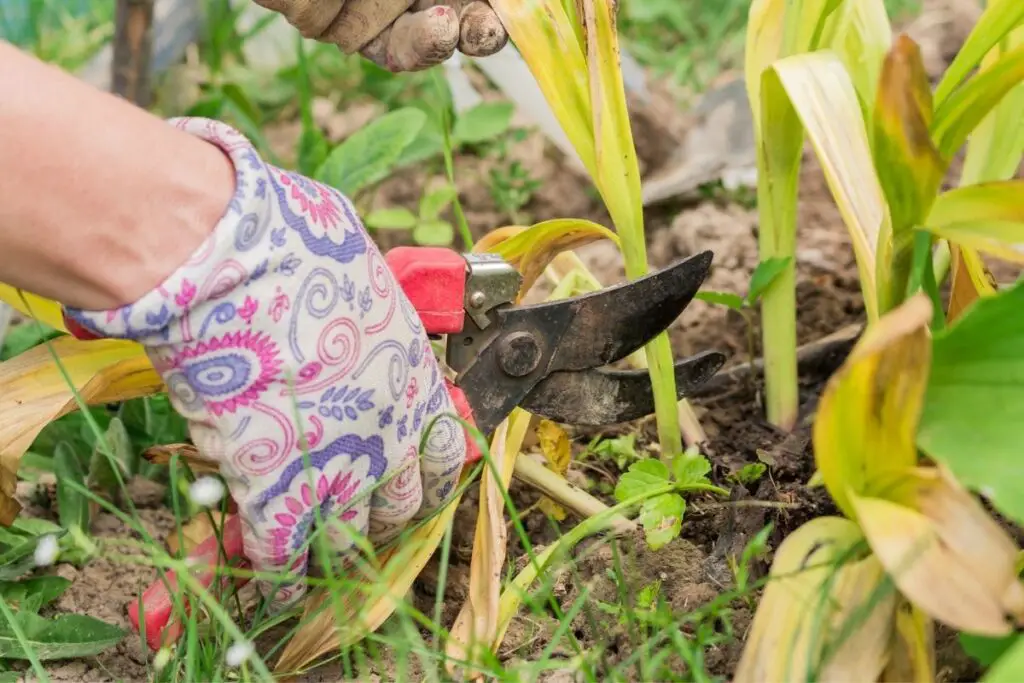Yellow leaves on tulips are considered a healthy part of their natural life cycle since yellowing indicates aging, which is natural to tulips like any other plant.
But if you find the leaves of tulips are turning yellow before the blooming period, it indicates that the plants are affected by some problems. In today’s article, we will find out the reasons why are your tulips turning yellow.
Overwatering is the primary cause of yellow leaves in tulips. Overwatering often damages the roots, due to which the plant cannot absorb adequate nutrients leading to yellow leaves. Other causes of yellow leaves include poor drainage, poor sunlight, nutrition deficiency, pest, and diseases.
To treat yellow leaves, you have to analyze each problem and determine the actual cause before the tulips get irreversible damage. So, let’s dive into further detail of the problem.

Are yellow leaves normal for tulips?
It is common for tulip leaves to turn yellow at the end of the growing season. Once the blooming season ends, the foliage will start reacting by turning yellow and then brown.
Aging is natural to tulip-like any other plant. Yellowing of leaves is not a concern for tulips, but it is unnatural if the leaves turn yellow before the blooming season ends.
There is some serious issue with your tulips if it has prematurely turned yellow. It can happen due to many reasons, such as unfavorable environment or poor soil conditions for tulips.
So do not take things lightly if you find premature yellow leaves. Overall, it is our responsibility as tulip parents to save them whenever we identify any signs.
An early response to this problem can save your tulip from future damage.
Whereas an ignorance of it won’t allow your tulips to have any blooms in the future.
Why are tulip leaves turning yellow?
When a plant leaf turns yellow, the phenomenon is known as chlorosis. The following are the possible reasons that cause tulip leaf chlorosis.
Overwatering

Overwatering can cause your tulip leaves to turn yellow. Tulips require significantly less watering or just an inch of water per week.
If there is heavy rainfall, late snowfall, or providing them with more an inch of water during their growing season, they will get overwatering problems.
They like well-drained sandy soil. They can survive in nutrition deficit soil but won’t be able to stand in soggy soil. They will get issues like root rot or bulbs root because of waterlogging.
Also read: How To Save Overwatered Tulips? (Possible Signs, Causes & How To Fix)
Underwatering
The leaves of tulips can also turn yellow due to underwatering. It is a rare problem, but if they don’t get an inch of water per week as per their requirements, tulip bulbs may dry beneath the soil.
A low moisture level for an extended period will dry out the roots and bulbs. It would become late by the moment you recognize the source of this problem.
Also read: How Often Do Tulips Need To Be Watered? (Tulip Watering Needs )
Inadequate sunlight
We all know that tulips thrive in bright direct sunlight, except for the warmer regions where they prefer shade to protect themselves from intense rays.
Both low light and excessive sunlight can cause your tulip leaves to turn yellow. Plants that don’t get enough light will undoubtedly have pale green or yellow leaves.
Similarly, too much sun exposure can also cause their foliage to burn due to dehydration, which brings yellow leaves.
Also read: How Much Sunlight Do Tulips Need? (Tulip Light Needs)
Alkaline soil
Tulips prefer slightly acidic to neutral soil with a pH level ranging between 6.0 to 7.0 on the pH scale. Soil that is too alkaline or too sweet in texture will seriously harm your plant’s development and turn its leaves yellow.
Also read: What Kind Of Soil Is Good For Tulips? (Best Soil Mix)
Looking for gardening supplies? We have tested 100's of products before recommending them to you guys. Check out our best pick below:
| Image | Gardening Supplies | Best Price? |
|---|---|---|
 Top
Top Top
Top | Raised Garden Bed Kit | Check On Amazon |
 | XLUX Soil Moisture Meter, Plant Water Monitor, Soil Hygrometer Sensor for Gardening, Farming, Indoor and Outdoor Plants, No Batteries Required | No Results |
 Top
Top Top
Top | 82 Pcs Garden Tools Set and Extra Succulent Tools Set | Check On Amazon |
 | Joeys Garden Expandable Garden Hose with 8 Function Hose Nozzle, Lightweight Anti-Kink Flexible Garden Hoses, Extra Strength Fabric with Double Latex Core, (50 FT, Black) | No Results |
 Top
Top Top
Top | Dual Chamber Compost Tumbler | Check On Amazon |
 Top
Top Top
Top | Sunnyglade Plant Stakes | Check On Amazon |
 Top
Top Top
Top | Organic Cold Pressed Neem Seed Oil | Check On Amazon |
 Top
Top Top
Top | Mighty Mint Gallon :-Insect and Pest Control Peppermint Oil | Check On Amazon |
 Top
Top Top
Top | Scotts DiseaseEx Lawn Fungicide | Check On Amazon |
 Top
Top Top
Top | Jacks Classic 20-20-20 All Purpose Fertilizer | Check On Amazon |
 Top
Top Top
Top | 30,000 Seeds Pollinator Attracting Wildflower Mixture | Check On Amazon |
 Top
Top Top
Top | Survival Vegetable Seeds Garden Kit-Over 16,000 Seeds | Check On Amazon |
Inadequate drainage
Proper drainage of soil is a crucial factor for a tulip’s life. A poorly drainage soil will cause even the right amount of water to pool.
Tulips don’t like to be in moist soil, and they prefer to grow in a raised bed or a pot with proper draining holes.
Tulips planted in low garden areas often suffer from drainage issues during rainfall and have root rot problems. Inadequate drainage will cause your tulips leaves to turn yellow before maturing.
Poor Nutrition

Sometimes yellow leaves are an indication that your plants are not getting enough nutrition. Your tulips may have yellow leaves if they are not getting proper nitrogen from the soil.
Even a soil test sometimes cannot accurately measure the nitrogen level of the soil. Although many varieties of tulips can survive in low-nutrition soil, providing them with nutrition is necessary to ensure a better bloom.
Also read: What Is The Best Fertilizer For Tulips? (Organic+Inorganic)
Pests
Tulips are not prone to pest problems, but tulips that are stressed by excessive heat and moisture often become vulnerable to pests. Certain pests like nematodes, mealybugs, rabbits, or stem borers can harm your tulips.
Organisms like nematodes that are soil-borne, microscopic feed on bulbs until they destroy them entirely. Whenever pests attack your tulips, you will find leaves are deformed, discolored, yellow on top, stunted, or has holes in them.
These pests are hazardous and immediate actions are required to cure them.
Also read: Bugs On Tulips: (Common Pests, Identification+How To Get Rid)
Diseases
Overwatering or heat stress may leave your tulip to be vulnerable to a particular disease. Diseases can be fungal, bacterial, or viral and may spread quickly if bulbs are planted too close together.
Close planting will cause humid conditions for bulbs which encourages fungal growth. Many times, the bulbs we buy have pathogens in them that later create growth problems.
Several diseases are responsible for yellow leaves, such as bacterial soft rot, tulip breaking virus, or fungal botrytis blight.
The damages caused by these diseases vary from rotting at bulb levels to the leaves turning deformed or discolored. Yellow tulips with deformities are most likely due to diseases or diseases caused by pests.
Shallow planting
Shallow planting is often a cause for tulip leaves turning yellow. It is said that you should place tulip bulbs at a depth of a minimum of 6 inches deep in the soil.
Deep planting will protect them from heat and dryness. However, even when they are deeply placed, sometimes they end up having shallow placements. This may happen if you are planting other plants with them or if the activity of squirrels is losing the soil.
Dry or wet conditions of winters often contribute to them rising a bit if they are newly planted in fall.
Also read: Should Tulips Be Planted In Groups? (How To+Care)
Infected bulbs
One common reason for your plant’s poor health is the use of infected bulbs. If you have purchased these bulbs from a gardener, there are fair chances that your bulbs have pathogens.
There are very few chances to know whether your bulbs are disease-free or not.
Improper vernalization
Tulips require vernalization which is the process of keeping bulbs in artificial winter conditions. This is done to wake the tulip bulbs from the dormancy period before planting. Vernalisation can encourage blooms at any time of the year.
Sometimes the bulbs you purchased might be vernalized bulbs. If the temperature for the vernalization process is not correct, your tulips will wilt and turn yellow before blooming season.
You should cool them at 40-45°F for 6-8 weeks. If the temperature is more than 55°F or the timing below five weeks, then your plant won’t bloom and will develop yellow leaves.
Also read: When’s The Best Time To Plant Tulips? (+After Plant Care)
How to fix yellow leaves in tulips?

To treat yellow leaves is to find out the reason behind them. An evaluation of each reason will allow you to take the necessary steps.
Now lets us check how to fix yellow leaves in tulips.
Fixing overwatering problem
If you are finding yellow leaves due to overwatering issues, do not water your plant until the soil becomes dry.
Another way to recover plants is by making holes in the soil. Here you need to make some deep holes in the soil at least 4-5 inches deep from their perimeter, then add some sand or compost to it.
The sand will absorb the excess moisture and will help in drainage.
You can also get a moisture meter for your plant to determine soil moisture and then water your plant accordingly. Avoid watering them in rainfall and cold winters.
Fixing underwatering problem
To fix under watering problem, change your tulips watering routine. Provide an inch of water every week as per their requirements.
Whenever you find the soil dusty, water immediately. Brittle roots and shrunken bulbs are challenging to revive. Still, you can give it a try.
Never let the soil dry completely, and check the soil twice every week. Always make adjustments in water as per the temperature and soil conditions.
Fixing lighting
Tulips need 6 hours of bright direct sunlight. Ideally, you should place them in a location where they will get direct morning sunlight and stay protected from daytime sunlight.
In case of excess heat, you can also use shade nets to prevent overheating due to sunlight or place big potted plants beside the flower beds to prevent extreme heat from reaching them.
Fixing soil acidity
You need to maintain a proper soil pH level to prevent your tulip leaves from turning yellow. To fix soil acidity, you need to determine a soil pH test using a soil test kit before doing any amendments.
To increase the soil pH level, you can use wood ash encase to reduce the pH level and add organic mulch like peat moss or sulfur to the soil.
Improve drainage
You should prefer using a good quality sandy, well-drained soil mix with compost or coco peat for growing tulips. Also, plant them in raised beds or well-drained bulb pans to avoid drainage problems.
Buy good quality bulbs
You should buy bulbs sold by commercial cultivators that are less likely to have pathogens since they treat tulip bulbs and other flowering bulbs with fungicides or pesticides before planting them.
But chemically treated bulbs that are old can carry pathogens due to high moisture levels and poor ventilation in the warehouses. So It’s always better to treat your bulbs with fungicides before planting.
Fix fertilization problem
To overcome nutritional problems for your tulips, amend the soil with an all-purpose slow-release fertilizer with a nutrient ratio of 10:10:10 as per package instructions before each fall and spring.
You can also opt for an excellent nutritional recipe for your tulips before planting them.
To prepare this, add 30% compost, 10% bone meal, 5% perlite 5% coco peat with 50% of sand and soil in equal amounts. This recipe will maintain a higher nutritional level for tulips.
Treating pests and diseases

Pests and diseases are the biggest problems for yellow leaves in tulips. They suck out plant nutrients and make them weak and vulnerable, so treat them before too late. First, you should destroy the affected plants to prevent any further spread of these pests or diseases.
There are many ways to treat pests. First, try an environment-friendly approach for removing them. Water your plant with a strong force so that all the pests will fall from the plant, or you can remove them by handpicking.
You can spray the foliage with organic pesticides such as a 2% neem oil solution twice every week, and this solution will remove all the bugs and keep the plant safe.
You can even apply horticulture oil or dish soap to prevent pests. You can add fungicide powder to the soil to prevent fungal attacks, or you can go for hot water treatment for your plant.
Always keep your plant’s roots dry, avoid over-mulching, and buy high-quality bulbs to ensure a safe planting. You can even build a fence around your tulips plants to prevent invaders like rabbits or squirrels.
Maintain proper depth and spacing
It is always recommended to plant bulbs deeper in soil. Plant them 8 inches deep in the soil in warmer regions to protect them from excessive heat and winters.
If you find that your tulip bulbs have risen to the surface, then cover it with garden soil or compost before the winter dormancy breaks.
Shallow planting will not protect them from increasing temperatures and can easily damage the open, uncovered tulips bulbs.
Ensure proper vernalization
You should always maintain proper timing and temperature for vernalization. Vernalise and cool bulbs for 45-55 degrees for a minimum of 6 weeks before planting.
After the cooling process, warm the bulbs so that they can develop leaves and flower stem. Early forcing will result in faster blooming, yet it will damage the plant.
The force process will take a minimum of 4 weeks, and after that, you can keep the tulips in a greenhouse or in a sunny garden spot to make them grow and bloom.
Final words
- Yellow leaves are typical for tulips with aging, but if tulip leaves turn yellow before blooming, find out the reason behind it.
- If you are aware of the reasons, take immediate action. It will help your plant from turning completely yellow.
- If yellow leaves are due to aging, then avoid pruning and wait for the leaves to die back naturally, but it’s due to some other cause, then prune the leaves and treat your plant well.
- Always buy good-quality bulbs and use a well-drained sand soil mix for planting.
- Keep a keen look at the drainage or moisture level of the soil. Water the plant as per its requirements, do not overwater it. Keep the soil dry and not moist. Ensure that the plant is not standing on water.
- Do deep planting and grow your tulips in raised beds and space them well.
- Keep them away from pests and diseases, apply neem oil or pesticides to prevent any attack.
- Understand the potential issues and work on the necessary adjustments as needed, and you will be gifted with beautiful tulip blooms.
Source: Wikipedia.
